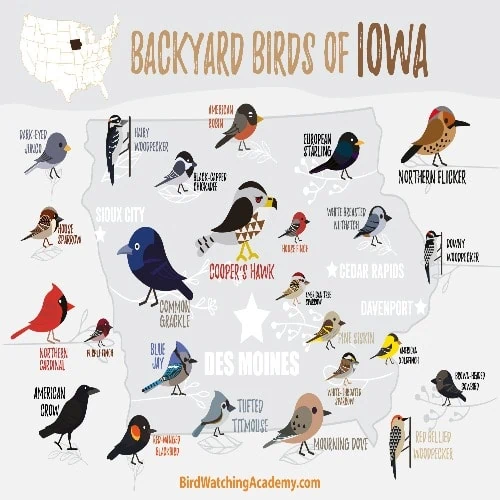The Audubon Society notes that there are almost 400 bird species in Iowa.
Therefore:
You'll have an exciting experience seeing this or that species whenever you go birding.
Even better, you can wait for some birds on your deck as they love suet feeders. The smaller ones can make your mornings melodious as they sing from a window feeder.
Can we now list some of the most common birds of Iowa? Let's go!
20 Iowa Birds To See Today
Iowa has such a vast avian population that you can choose to see woodpeckers, sparrows, or warblers only and still have a memorable birding experience. We'll talk about different birds you'll see wherever you are in this state.
1. American Goldfinch
This short-distance migrant flies from its breeding range in the north to winter in states like Florida.
It's easy to pick out an American goldfinch from a flock that visits your feeder because of the bird's stunning yellow plumage.
A male has a black cap to match its black wings, while a female has the same black and yellow plumage but paler. However, the nonbreeding male isn't as colorful with unstreaked brown instead of yellow feathers.
Look for this eastern goldfinch by the roadside or in weedy fields and floodplains.
Lastly, the American goldfinch is Iowa's state bird.
2. American Robin
Start with the American robin if you're looking for Iowa birds that are easy to ID.
It has a rusty underside, a gray back, a yellow bill, and its head is black. A female robin has a pale belly, a grayish back, and black eyes with a white circle around them.
An American robin will come looking for earthworms in your backyard. You can also attract it by planting berries like sumac.
3. House Finch
Initially, you could only see it in western states, but it's now one of the birds in Iowa.
This finch won't have you exploring woodlands or wetlands as you can spot it in cities and residential areas. You'll not miss it as it's a noisy bird when in a flock.
A male house finch has a striking rosy face and breast, while a female has a grayish-brown underside. These two features will help you differentiate them at your feeder.
Pro Tip: You could install several finch feeders in your backyard so that the birds won't crowd each other.
4. Red-bellied Woodpecker
This eastern bird species has a resident population in Iowa. It's medium-sized at 9.4 inches, almost the size of a hairy woodpecker.
You'll know it by its barred back and a pale underside. Also, a male red-bellied bird has red feathers from the crown down to the nape.
This avian loves woodlands and backyard feeders. When it collects a large nut, it inserts it in a crack on a tree and cracks it open with its bill. Watch out for such activity.
5. Northern Cardinal
It's one of the most common Iowa birds, one that you'll see almost every time you go birding.
A male bird has stunning bright red plumage and a red crest, while a female cardinal has brownish plumage. But, it also has a crest, which will help you distinguish it from other common backyard birds. Yes, the northern cardinal is a backyard visitor that loves foraging on the ground for centipedes.
Pro Tip: Make your backyard visitor feel at home with other fellow cardinals by installing the best bird feeders for cardinals to lure them more.
6. Bald Eagle
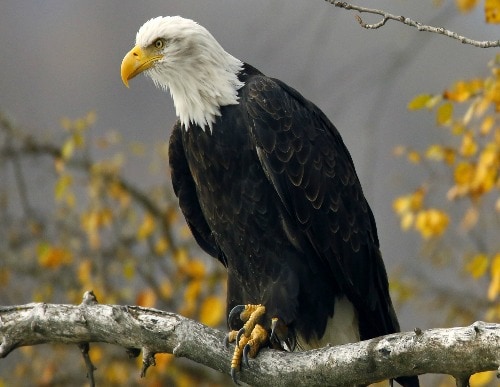
The bald eagle is a large bird with a bill-to-tail length between 27.9 and 37.8 inches.
It soars with broad and long wings, displaying its dark brown body, white head, and tail.
The resident birds live along the coast only where they enjoy plenty of fish, carrion, waterfowl, and small mammals.
The ones in Iowa are in the wintering range, and their migration pattern depends on many factors like food and the weather.
7. House Sparrow
Most homeowners can't stand house sparrows because they don't obey boundaries. They build nests on any structure and look for food in the trash.
But, beyond these annoying habits, a house sparrow is a thrilling backyard visitor that loves bathing in a pool of dirt whenever it finds some in a backyard.
Male and female sparrows have different plumage. A male's crown is gray, and its cheeks are white. It also flaunts a black bib. A female house sparrow has a pale back and a grayish-brown underside.
There's a resident population of house sparrows throughout North and Central America. Plus, this sparrow inhabits some countries in South America, such as Brazil and Peru.
8. Mourning Dove
It's one bird that could spend all its time in a bird feeder if it could. It doesn't even like woodlands like most bird species and instead prefers to perch on telephone lines.
If it's not on telephone lines, you'll see it in dense foliage or nesting on the ground undisturbed. A mourning dove's variety of habitats near human settlements must be the reason it loves crop grains and wild grass.
The rusty body of a mourning dove is unmistakable. But, it doesn't have brown plumage only as its back has sparse black spots. You'll note its peachy underside and pink feet when you see it from below.
9. Downy Woodpecker
You must have seen a downy woodpecker before because it's a resident bird everywhere in North America.
It's not a large bird as it averages 5.5 to 6.7 inches long. Another identification feature is its plumage. The male bird in the Eastern states has a white back, black wings with white spots, red nape, and a white underside.
It also flaunts black and white stripes on its head. The female's underside is grayish, and it doesn't have a red nape. So, where do downy woodpeckers live? Search for them in woodlands as they love deciduous trees.
However, if there are no forests near you, a simple backyard feeder can attract these woodpeckers. They eat acorns and insects in the wild, but you can feed them seeds, berries, and suet.
Pro Tip: Install only the best bird suet feeder for woodpeckers to attract them into your backyard more often!
10. Blue Jay
This aggressive avian is as common as the northern cardinal, and it also comes to backyards, more so if you have a suet feeder.
It's easy to pick it out from the flocks on your property because of its blue feathers. A blue jay has blue upper parts and a white underside. A closer look at a male blue jay reveals a black necklace.
This bird can mimic a red-shouldered hawk to warn the flock when a predator lurks. However, it also has predatory habits because it eats eggs and nestlings.
11. Black-capped Chickadee
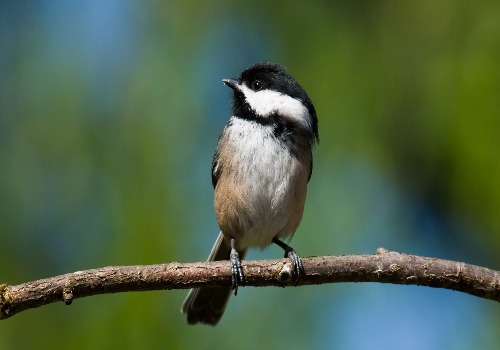
You'll see it almost as often as a northern cardinal. So, what features should you use to ID it? First, spot a white belly, white cheeks, and a black cap.
It loves bird feeders because there's always a generous supply of seeds it can carry to stash somewhere. So, once you ID there's a black capped chickadee in your backyard, watch it carry seeds to its secret store.
This chickadee's favorite habitat in the wild includes wooded shrubs and forests. It builds nests in alder and birch trees or takes over holes drilled by a downy woodpecker.
It doesn't migrate, and it inhabits most of the central area of North America. But, there may be an irruption when there's high reproduction.
12. American Crow
Iowa has a resident population of crows; therefore, you can see them all year round.
An American crow has glossy black plumage, a short tail, and a large head. Its primary flight feathers look like fingers when it spreads them in the sky. When there's a roost nearby, you'll hear unique cawing calls that can keep you awake.
It's not the best backyard visitor as you'll see it around your trash picking edibles out. On top of that, it's predatory and easts nestlings and eggs.
13. Song Sparrow
It's one of the backyard birds of Iowa that are easy to ID because it has brown streaks on the back and similar streaks on the breast.
You'll also ID this medium-sized bird by its rounded tail and head. There's a resident population in some eastern and western states, while the breeding range is north and the migrating birds winter south as far as Florida.
This songbird will keep you awake when the male sings to defend its territory or attract a mate.
14. Northern Harrier
Iowa has a resident population of the northern harrier. This leapfrog migrant leaves its breeding range north to winter in southern states.
Distinguishing features to ID a northern harrier include its long tail, grayish back, broad wings, and white rump. A female harrier has brown streaks on its underside.
This large bird grows to 19.7 inches long, and its diet includes songbirds, reptiles, and small mammals.
15. Hairy Woodpecker

This medium-sized woodpecker is larger than a downy. Even though it has the same black and white plumage as a downy woodpecker, it has a longer, sturdier bill. That's the best way to differentiate it from a downy woodpecker.
Since the two species inhabit the same range, you'll spot a downy in small branches and a hairy on trunks.
Even though it digs holes, it also trails the drilling done by a pileated woodpecker to capture any insects left behind. On top of that, you'll see a hairy woodpecker drinking sap from wells dug by a sapsucker.
16. Barn Swallow
Most of North America is the breeding range of the barn swallow. This long-distance migrant flies into Central America to winter, proceeding further south into South America.
It's a medium-sized bird between 5.9 and 7.5 inches long, with pointed wings and broad shoulders.
One of the first places to spot a barn swallow might be the mud puddle in your neighborhood. That's where it collects mud during the breeding season.
Unlike other backyard visitors that love seed and suet, this one would prefer you offer eggshells or oyster shells served on a platform feeder.
17. Chipping Swallow
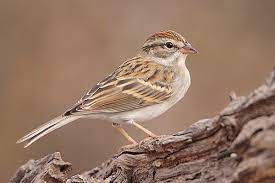
Iowa, like most of North America, is in the breeding range. The chipping sparrow migrates to California, Florida, and Mexico.
It's a ground-feeding avian that perches in the canopy of small trees from where it fills the air with loud trills. If you have a feeder with black-oil sunflower seeds, look for small birds, even smaller than a song sparrow, with streaks on its back and a gray belly.
18. Red winged Blackbird
This blackbird eats insect larvae, spiders, and berries. You'll see it in wetlands and open fields, but the best location to see a red-winged blackbird is in a residential area, as it loves perching on telephone posts.
Nesting sites include woodlands and marshes and as you explore these grounds, stay a distance from its nest because it's aggressive when protecting its home.
A red-winged blackbird has black plumage with red and yellow shoulder patches. A female doesn't have such bold colors; it has brown streaks instead of black plumage.
There's a resident population in Iowa, and most of the northern region of the continent serves as the breeding range. These birds later fly a short distance to winter up to 800 miles away in California and Mexico.
19. Eastern Bluebird

Iowa is in the breeding range of the eastern bluebird. This population flies up to 2,000 miles away to winter in Texas, Mexico, and other southern areas.
This thrush averages 6.3 to 8.3 inches long. You can tell the sexes apart by their plumage as a male has a blue back and a reddish belly while a female's back is grayish and its belly is orange-brown. Further, a female bluebird has bluish plumage on its wings and tail.
It's a backyard bird that loves mealworms. Nonetheless, it eats berries and insects in meadows, golf courses, and other open fields.
20. White-breasted Nuthatch
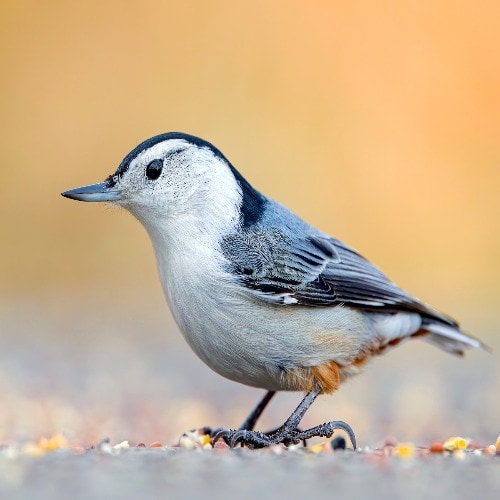
Most states of the U.S. have a resident population of the white-breasted nuthatch, so you'll see it in Iowa all year round.
You'll note its small size, grayish-blue back, black cap, white face, and white underside.
You can attract a white-breasted nuthatch to your feeder with sunflower seeds or peanuts offered in a suet or tube feeder.
But, you can also see it in deciduous or coniferous forests if there are no woodlands near you.
These habitats have a supply of the bird's favorite foods - acorns and hawthorns. It has such an intricate way of cracking acorns by inserting them in a tree bark then breaking them open with its bill. You should see a nuthatch cracking acorns.
Where To See Birds In Iowa
To prove how serious Iowa is about birds, check out the avian archive at the Iowa State University. It's a collection of sightings of various species and information about them.
There are numerous Important Bird Area zones in this state, especially in the eastern region.
There's also the Missouri River in western Iowa and the Mississippi River in the east, two features that boost birdlife. If you'd prefer visiting birding trails, this state has three: one in Loess Hills, another parallel to the Mississippi River, and a third one called Makoke Trail.
Let's look at a few birding zones:
1. Saylorville Reservoir
You'll see about 300 species in the parks near the lake. One such attraction is Jester Park, which boasts about 250 avian species, including bald eagles, ospreys, and grebes.
2. Red Rock Reservoir
It's near Des Moines River, so expect to see many grebes, waterfowls, gulls, and bald eagles. The best time to explore this area is from fall to spring.
3. Great River Birding Trail
It's one of the three trails we mentioned earlier, and it's the one running parallel to the Mississippi River. Where there are backwaters, you'll meet wood ducks any time of the year. In winter, other birds like the mallards join these ducks. Forests on the banks of this mighty river are nesting grounds for barred owls and warblers.
Frequently Asked Question
How do you attract songbirds in Iowa?
The Iowa Department of Natural Resources suggests that you get the right food for the wild birds you're attracting to your yard. Favorites for most birds are insects, mealworms, berries, and seeds. They have different feeding habits and prefer different feeder designs like platform and suet feeders.
Thus, you have to know the specific birds you want in your yard. Also, native plants like prairie grass provide nesting material and a home for songbirds.
When these birds start visiting your backyard, you'll need to clean your feeder, birdhouse, and birdbath. It's also up to you to reduce attacks from predators, whether you have to make the backyard hostile to them by removing feeders loved by predators.
Do goldfinches stay in Iowa for the winter?
Yes, they do! The Cornell Lab map shows a resident population in Iowa and other eastern states. You can see the Iowa state bird all year round. But, there are other goldfinches in the breeding range in Canada, where they stay from July to mid-September before flying south to wintering grounds in Florida, Texas, and California.
What is the most common bird in Iowa?
The northern cardinal is the most prominent species throughout the year. It has a resident population in the eastern states, including Iowa. It's a popular species as seven states picked it as their state bird.
Conclusion
There are birds everywhere in this state, meaning you'll tour most of the region during birding excursions. If you're a backyard birder, we have highlighted common species such as the northern cardinal that'll treat you to songs throughout the year.
We also gave you a list of birding spots in this state for out-of-home excursions on riverbanks and woodlands. Do you want to start in your backyard or go birding in a park?

